| Weight | 1 lbs |
|---|---|
| Dimensions | 9 × 5 × 2 in |
| host | rabbit |
| isotype | IgG |
| clonality | polyclonal |
| concentration | 1 mg/mL |
| applications | ICC/IF, WB |
| reactivity | ATR |
| available sizes | 100 µg |
rabbit anti-ATR polyclonal antibody 8335
$518.00
Antibody summary
- Rabbit polyclonal to ATR
- Suitable for: WB,IP
- Isotype: Whole IgG
- 100 µg
rabbit anti-ATR polyclonal antibody 8335
| target relevance |
|---|
| Protein names Serine/threonine-protein kinase ATR (EC 2.7.11.1) (Ataxia telangiectasia and Rad3-related protein) (FRAP-related protein 1) |
| Gene names ATR,ATR FRP1 |
| Protein family PI3/PI4-kinase family, ATM subfamily |
| Mass 301367Da |
| Function FUNCTION: Serine/threonine protein kinase which activates checkpoint signaling upon genotoxic stresses such as ionizing radiation (IR), ultraviolet light (UV), or DNA replication stalling, thereby acting as a DNA damage sensor (PubMed:10597277, PubMed:10608806, PubMed:10859164, PubMed:11721054, PubMed:12791985, PubMed:12814551, PubMed:14657349, PubMed:14729973, PubMed:14742437, PubMed:15210935, PubMed:15496423, PubMed:16260606, PubMed:21144835, PubMed:21777809, PubMed:23273981, PubMed:25083873, PubMed:27723717, PubMed:27723720, PubMed:30139873, PubMed:33848395, PubMed:37788673, PubMed:37832547, PubMed:9427750, PubMed:9636169). Recognizes the substrate consensus sequence [ST]-Q (PubMed:10597277, PubMed:10608806, PubMed:10859164, PubMed:11721054, PubMed:12791985, PubMed:12814551, PubMed:14657349, PubMed:14729973, PubMed:14742437, PubMed:15210935, PubMed:15496423, PubMed:16260606, PubMed:21144835, PubMed:23273981, PubMed:27723717, PubMed:27723720, PubMed:33848395, PubMed:9427750, PubMed:9636169). Phosphorylates BRCA1, CHEK1, MCM2, RAD17, RBBP8, RPA2, SMC1 and p53/TP53, which collectively inhibit DNA replication and mitosis and promote DNA repair, recombination and apoptosis (PubMed:11114888, PubMed:11418864, PubMed:11865061, PubMed:21777809, PubMed:23273981, PubMed:25083873, PubMed:9925639). Phosphorylates 'Ser-139' of histone variant H2AX at sites of DNA damage, thereby regulating DNA damage response mechanism (PubMed:11673449). Required for FANCD2 ubiquitination (PubMed:15314022). Critical for maintenance of fragile site stability and efficient regulation of centrosome duplication (PubMed:12526805). Acts as a regulator of the S-G2 transition by restricting the activity of CDK1 during S-phase to prevent premature entry into G2 (PubMed:30139873). Acts as a regulator of the nuclear envelope integrity in response to DNA damage and stress (PubMed:25083873, PubMed:37788673, PubMed:37832547). Acts as a mechanical stress sensor at the nuclear envelope: relocalizes to the nuclear envelope in response to mechanical stress and mediates a checkpoint via phosphorylation of CHEK1 (PubMed:25083873). Also promotes nuclear envelope rupture in response to DNA damage by mediating phosphorylation of LMNA at 'Ser-282', leading to lamin disassembly (PubMed:37832547). Involved in the inflammatory response to genome instability and double-stranded DNA breaks: acts by localizing to micronuclei arising from genome instability and catalyzing phosphorylation of LMNA at 'Ser-395', priming LMNA for subsequent phosphorylation by CDK1 and micronuclei envelope rupture (PubMed:37788673). The rupture of micronuclear envelope triggers the cGAS-STING pathway thereby activating the type I interferon response and innate immunity (PubMed:37788673). Positively regulates the restart of stalled replication forks following activation by the KHDC3L-OOEP scaffold complex (By similarity). {ECO:0000250|UniProtKB:Q9JKK8, ECO:0000269|PubMed:10597277, ECO:0000269|PubMed:10608806, ECO:0000269|PubMed:10859164, ECO:0000269|PubMed:11114888, ECO:0000269|PubMed:11418864, ECO:0000269|PubMed:11673449, ECO:0000269|PubMed:11721054, ECO:0000269|PubMed:11865061, ECO:0000269|PubMed:12526805, ECO:0000269|PubMed:12791985, ECO:0000269|PubMed:12814551, ECO:0000269|PubMed:14657349, ECO:0000269|PubMed:14729973, ECO:0000269|PubMed:14742437, ECO:0000269|PubMed:15210935, ECO:0000269|PubMed:15314022, ECO:0000269|PubMed:15496423, ECO:0000269|PubMed:16260606, ECO:0000269|PubMed:21144835, ECO:0000269|PubMed:21777809, ECO:0000269|PubMed:23273981, ECO:0000269|PubMed:25083873, ECO:0000269|PubMed:27723717, ECO:0000269|PubMed:27723720, ECO:0000269|PubMed:30139873, ECO:0000269|PubMed:33848395, ECO:0000269|PubMed:37788673, ECO:0000269|PubMed:37832547, ECO:0000269|PubMed:9427750, ECO:0000269|PubMed:9636169, ECO:0000269|PubMed:9925639}. |
| Catalytic activity CATALYTIC ACTIVITY: Reaction=L-seryl-[protein] + ATP = O-phospho-L-seryl-[protein] + ADP + H(+); Xref=Rhea:RHEA:17989, Rhea:RHEA-COMP:9863, Rhea:RHEA-COMP:11604, ChEBI:CHEBI:15378, ChEBI:CHEBI:29999, ChEBI:CHEBI:30616, ChEBI:CHEBI:83421, ChEBI:CHEBI:456216; EC=2.7.11.1; Evidence={ECO:0000269|PubMed:23273981, ECO:0000269|PubMed:27723717, ECO:0000269|PubMed:27723720, ECO:0000269|PubMed:37788673, ECO:0000269|PubMed:37832547}; PhysiologicalDirection=left-to-right; Xref=Rhea:RHEA:17990; Evidence={ECO:0000269|PubMed:23273981, ECO:0000269|PubMed:27723717, ECO:0000269|PubMed:27723720, ECO:0000269|PubMed:37788673, ECO:0000269|PubMed:37832547}; CATALYTIC ACTIVITY: Reaction=L-threonyl-[protein] + ATP = O-phospho-L-threonyl-[protein] + ADP + H(+); Xref=Rhea:RHEA:46608, Rhea:RHEA-COMP:11060, Rhea:RHEA-COMP:11605, ChEBI:CHEBI:15378, ChEBI:CHEBI:30013, ChEBI:CHEBI:30616, ChEBI:CHEBI:61977, ChEBI:CHEBI:456216; EC=2.7.11.1; Evidence={ECO:0000269|PubMed:21705319, ECO:0000269|PubMed:21777809, ECO:0000269|PubMed:27723717, ECO:0000269|PubMed:27723720}; PhysiologicalDirection=left-to-right; Xref=Rhea:RHEA:46609; Evidence={ECO:0000269|PubMed:21705319, ECO:0000269|PubMed:21777809, ECO:0000269|PubMed:27723717, ECO:0000269|PubMed:27723720}; |
| Subellular location SUBCELLULAR LOCATION: Nucleus {ECO:0000269|PubMed:11114888, ECO:0000269|PubMed:11721054, ECO:0000269|PubMed:11865061, ECO:0000269|PubMed:12814551, ECO:0000269|PubMed:14871897, ECO:0000269|PubMed:16260606, ECO:0000269|PubMed:18283122, ECO:0000269|PubMed:27723720, ECO:0000269|PubMed:8843195}. Chromosome {ECO:0000269|PubMed:11673449}. Nucleus envelope {ECO:0000269|PubMed:25083873, ECO:0000269|PubMed:37788673, ECO:0000269|PubMed:37832547}. Note=Depending on the cell type, it can also be found in PML nuclear bodies (PubMed:12814551). Recruited to chromatin during S-phase (PubMed:14871897). Redistributes to discrete nuclear foci upon DNA damage, hypoxia or replication fork stalling (PubMed:27723720). Relocalizes to the nuclear envelope in response to mechanical stress or DNA damage (PubMed:25083873, PubMed:37832547). Also localizes to the micronuclear envelope in response to response to genome instability (PubMed:37788673). {ECO:0000269|PubMed:12814551, ECO:0000269|PubMed:25083873, ECO:0000269|PubMed:27723720, ECO:0000269|PubMed:37788673, ECO:0000269|PubMed:37832547}. |
| Tissues TISSUE SPECIFICITY: Ubiquitous, with highest expression in testis. {ECO:0000269|PubMed:11470508, ECO:0000269|PubMed:8610130, ECO:0000269|PubMed:8843195}.; TISSUE SPECIFICITY: [Isoform 2]: Isoform 2 is found in pancreas, placenta and liver but not in heart, testis and ovary. {ECO:0000269|PubMed:11470508}. |
| Structure SUBUNIT: Forms a heterodimer with ATRIP, forming the ATR-ATRIP complex (PubMed:11721054, PubMed:12791985, PubMed:14729973, PubMed:15758953, PubMed:21777809). Present in a complex containing ATRIP and RPA-coated single-stranded DNA (PubMed:12791985, PubMed:14729973). Binds to DNA, and to UV-damaged DNA with higher affinity (PubMed:12791985). Interacts with MSH2 and HDAC2 (PubMed:14657349). Present in a complex containing CHD4 and HDAC2 (PubMed:10545197). Interacts with EEF1E1, the interaction is enhanced by UV irradiation (PubMed:15680327). Interacts with CLSPN and CEP164 (PubMed:12766152, PubMed:18283122). Interacts with TELO2 and TTI1 (PubMed:20427287, PubMed:20801936, PubMed:20810650). Interacts with BCR-ABL after genotoxic stress (PubMed:15050919). Interacts with UHRF2; this interaction promotes ATR activation (PubMed:33848395). Interacts (when phosphorylated) with TOPBP1; interaction takes place when ATR is autophosphorylated at Thr-1989, leading to ATR activation by TOPBP1 (PubMed:21705319, PubMed:21777809). {ECO:0000269|PubMed:10545197, ECO:0000269|PubMed:11721054, ECO:0000269|PubMed:12766152, ECO:0000269|PubMed:12791985, ECO:0000269|PubMed:14657349, ECO:0000269|PubMed:14729973, ECO:0000269|PubMed:15050919, ECO:0000269|PubMed:15680327, ECO:0000269|PubMed:15758953, ECO:0000269|PubMed:18283122, ECO:0000269|PubMed:20427287, ECO:0000269|PubMed:20801936, ECO:0000269|PubMed:20810650, ECO:0000269|PubMed:21705319, ECO:0000269|PubMed:21777809, ECO:0000269|PubMed:33848395}. |
| Post-translational modification PTM: Phosphorylated (PubMed:21144835). Autophosphorylation at Thr-1989 in response to DNA damage promotes interaction with TOPBP1 and activation of ATR (PubMed:21705319, PubMed:21777809). {ECO:0000269|PubMed:21144835, ECO:0000269|PubMed:21705319, ECO:0000269|PubMed:21777809}. |
| Involvement in disease DISEASE: Seckel syndrome 1 (SCKL1) [MIM:210600]: A rare autosomal recessive disorder characterized by proportionate dwarfism of prenatal onset associated with low birth weight, growth retardation, severe microcephaly with a bird-headed like appearance, and intellectual disability. {ECO:0000269|PubMed:12640452}. Note=The disease is caused by variants affecting the gene represented in this entry.; DISEASE: Cutaneous telangiectasia and cancer syndrome, familial (FCTCS) [MIM:614564]: A disease characterized by cutaneous telangiectases in infancy with patchy alopecia over areas of affected skin, thinning of the lateral eyebrows, and mild dental and nail anomalies. Affected individuals are at increased risk of developing oropharyngeal cancer, and other malignancies have been reported as well. {ECO:0000269|PubMed:22341969}. Note=The disease is caused by variants affecting the gene represented in this entry. |
| Target Relevance information above includes information from UniProt accession: Q13535 |
| The UniProt Consortium |
Data
Publications
| pmid | title | authors | citation |
|---|---|---|---|
| We haven't added any publications to our database yet. | |||
Protocols
| relevant to this product |
|---|
| Western blot |
Documents
| # | SDS | Certificate | |
|---|---|---|---|
| Please enter your product and batch number here to retrieve product datasheet, SDS, and QC information. | |||
Only logged in customers who have purchased this product may leave a review.
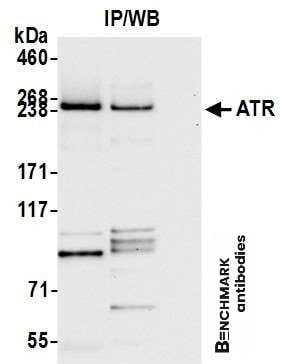
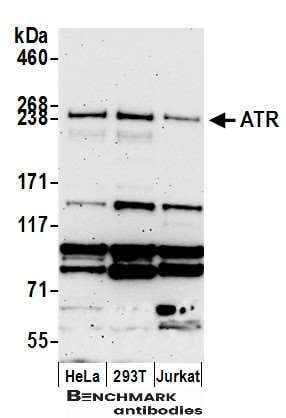

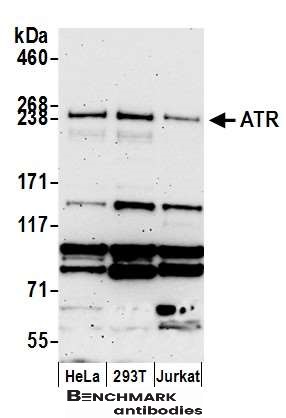
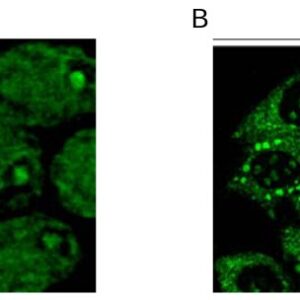
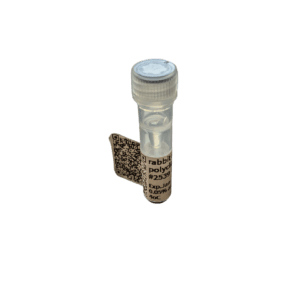
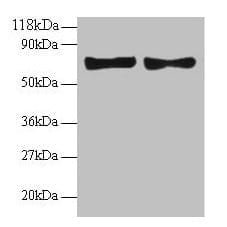
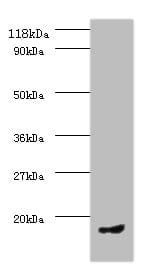

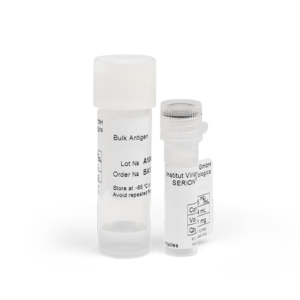
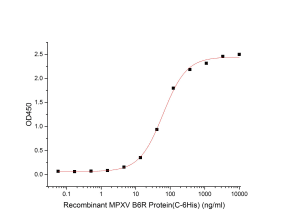
Reviews
There are no reviews yet.